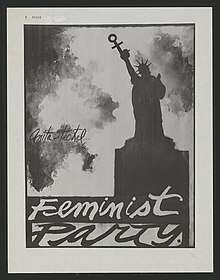Anita Steckel
Anita Slavin Arkin Steckel (February 24, 1930 – March 16, 2012) was an American feminist artist known for paintings and photomontages with sexual imagery. She was also the founder of the arts organization "The Fight Censorship Group", whose other members included Hannah Wilke, Louise Bourgeois, Judith Bernstein, Martha Edelheit, Eunice Golden, Juanita McNeely, Barbara Nessim, Anne Sharpe and Joan Semmel.[1]
Anita Steckel | |
|---|---|
| Born | Anita Arkin February 24, 1930 Brooklyn, New York, United States |
| Died | March 16, 2012 Manhattan, New York, United States |
| Nationality | American |
| Education | Art Students League of New York |
| Known for | Painting and Photomontage |
| Awards | Pollock Krasner Grant (2005) |
Early life and education
Steckel was born in Brooklyn, New York, to Russian Jewish immigrants Dora and Hyman Arkin.[2][3] She had an abusive mother and a father who struggled with a gambling problem and left home after an early graduation from the High School of Music & Art in Manhattan (now Fiorello H. LaGuardia High School of Music & Art). As a single young woman, Steckel dated Marlon Brando and worked on a Norwegian freighter that traveled to South America for two months. She also worked as a dancing instructor, where she won a competition and was crowned the "Mambo Queen of Southern California".[3] She then went back to New York to study at Cooper Union, and Alfred University, as well as completing advanced study at the Art Students League of New York with Edwin Dickinson [4][5][6] She also taught for several years at The Art Students League of New York.[4][7] In 1970, Steckel moved to the Westbeth Artists' Housing in Manhattan, New York, where she lived the rest of her life.[3]
Artwork

Steckel began showing her work in both solo and group exhibitions beginning in the late 1960s.[6] Her first publicly recognized work, a photomontage series titled "Mom Art" in 1963, included critiques of racism, war, and sexual inequalities.[3][8] In her "Giant Woman" series of works, Steckel painted oversized nude women onto photographs of city scenes, an idea associated with a Women's movement theme that women had "outgrown their roles" in society as previously defined.[9] In 1972, her work was exhibited at the Women's Interart Center in New York alongside pieces by the influential feminist artists Judy Chicago, Miriam Schapiro and Faith Ringgold.[10][11]
Steckel came to public attention after her solo exhibition, The Sexual Politics of Feminist Art, held at Rockland Community College in 1972.[4][6] The exhibition was controversial because Steckel's work was sexually explicit and some local authorities called for the closure of the show.[4][12][13]
She created a series of artworks concerning erections, in defense of which she said, “If the erect penis is not wholesome enough to go into museums, it should not be considered wholesome enough to go into women.”[8]
In 2001, Steckel's work was exhibited at the Mitchell Algus Gallery.[14]
References
- Mark, Lisa Gabrielle, ed. (2007). WACK! Art and the Feminist Revolution. Cambridge, MA and London: MIT Press.CS1 maint: extra text: authors list (link)
- Levin, Gail (2007). "Censorship, Politics, and Sexual Imagery in the work of Jewish-American Feminist Artists". Nashim: A Journal of Jewish Women's Studies & Gender Issues. 14.
- Middleman, Rachel (2013). "Anita Steckel's Feminist Montage: Merging Politics, Art, and Life". Woman's Art Journal. 34 (1): 21–29. JSTOR 24395331.
- "Anita Steckel, artist who created erotic works dies at 82". The New York Times. March 25, 2012. Retrieved 16 April 2012.
- Amateau, Albert (April 5, 2012). "Anita Steckel, sexually provocative painter, was 82". The Villager. Retrieved 26 October 2012.
- "Anita Steckel CV" (PDF). Brooklyn Museum of Art. Retrieved 26 October 2012.
- "The Art Students League | Instructors". theartstudentsleague.org. Archived from the original on 4 March 2016. Retrieved 20 September 2015.
- Raub, Deborah Fineblum. "Of Peonies & Penises: Anita Steckel's Legacy". July 12, 2012. Jewish Women's Archive. Retrieved 12 January 2013.
- Middleman, Rachel. "Anita Steckel: The Feminist Art of Sexual Politics." Women in the Arts 32:1 (Winter/Spring 2014), pp. 22-25.
- "Group Shows". New York Magazine. February 14, 1972.
- "Anita Steckel - New York". Aud Art Gallery. Retrieved 12 January 2013.
- "Anita Steckel 2006". Mitchell Algus Gallery. oneartworld.com. Archived from the original on 2014-01-15. Retrieved 26 October 2012.
- "Anita Steckel". Frieze Magazine. October 2009. Archived from the original on 9 January 2013. Retrieved 12 January 2013.
- Goddard, Donald (2001). "Anita Steckel: Self-Images and Montages". The New York Art World. Retrieved 12 January 2013.
External links
- "Anita Steckel". Brooklyn Museum - Elizabeth A. Sackler Center for Feminist Art: Feminist Art Base: Anita Steckel. Retrieved 12 January 2013.
- The Estate of Anita Steckel Official Website
- Anita Steckel Papers, 1940-2012 at National Museum of Women in the Arts